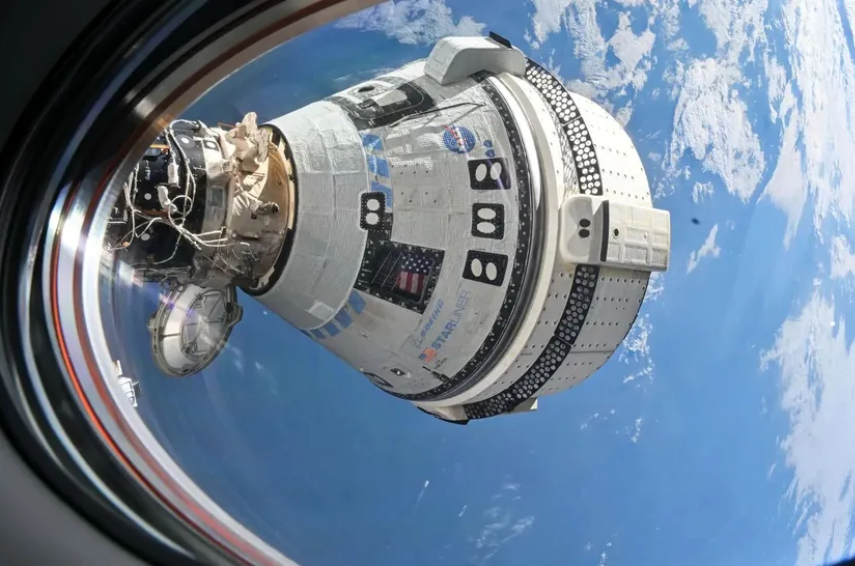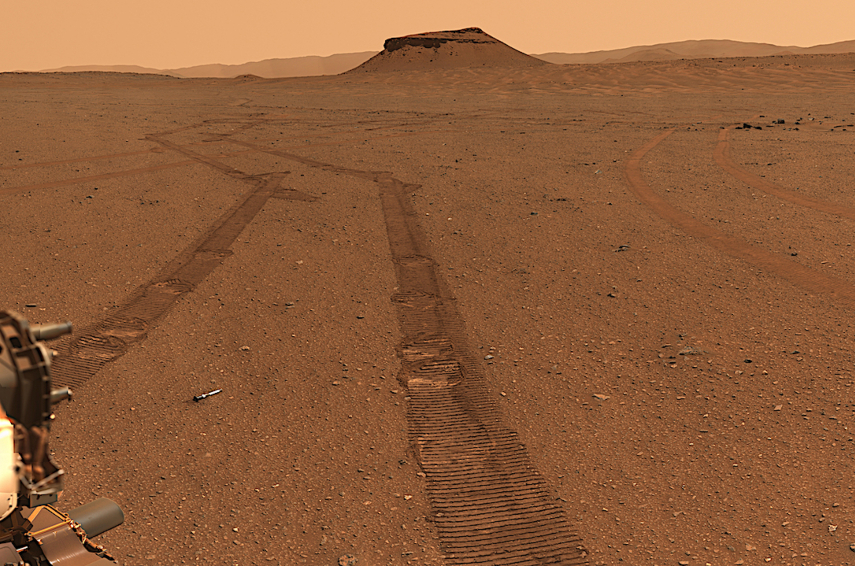Missed Shots and Milestones: This Week in Space
Disappointment as the continuation of the Israeli experiment to photograph sprite lightning from space comes back empty-handed, another delay for Boeing's spacecraft, a travel record on Mars, and the birth of new planets. This Week in Space
Returned Empty-Handed
Axiom Space’s fourth private mission to the International Space Station (ISS), AX-4, wrapped up successfully last Monday, with the safe return to Earth of its four-person crew after 18 days in orbit. The team included Axiom mission commander and veteran astronaut Peggy Whitson—on her fifth ISS flight—and three representatives from national space agencies: Shubhanshu Shukla from India, Sławosz Uznański-Wiśniewski from Poland, and Tibor Kapu from Hungary.
During their stay, the astronauts conducted dozens of scientific and medical experiments. One of the goals was to continue an Israeli experiment aimed at photographing atmospheric phenomena that occur above thunderclouds during storms — elusive bursts of light known as sprite lightning, elves, and similar events. These colorful and dramatic flashes of light span tens of kilometers but last only milliseconds, too brief for the human eye to perceive unaided.
To capture such fleeting phenomena, the astronauts on the ISS need precise information about the location and timing of occurrence of thunderstorms, and must direct high-speed cameras accordingly. The high-frequency footage of the storms can later be analyzed to identify the phenomena and track their stages of development.
This version of the experiment was first conducted by private astronaut Eytan Stibbe during the AX-1 mission in 2022, as part of the Israeli “Rakia Mission.” Since then, Rakia has become a public benefit corporation, continuing to lead the experiment on all subsequent Axiom missions, with varying degrees of success. The scientific effort is headed by Prof. Yoav Yair of Reichman University, who directs the astronauts on where to film by cross-referencing storm forecasts with the ISS’s flight path. The project is, in fact, a continuation of an experiment originally carried out by Israeli astronaut Ilan Ramon during the Columbia space shuttle mission in 2003, and which Yair has continued in collaboration with several researchers and astronauts aboard the ISS.
This time, the experiment was led by a Hungarian team led by Prof. József Bór of the Hungarian Institute of Earth Physics and Space Science. Hungarian astronaut Tibor Kapu was designated to carry out the observations, but Prof. Yoav Yair and his team trained the entire crew in operating the camera and provided the station with precise daily forecasts.
Unfortunately, the experiment did not produce the expected results. “Unfortunately, they didn’t capture much, and from a preliminary analysis of the images, they didn’t deliver the goods,” Yair told the Davidson Institute website. ““During the second half of the mission, the station’s orbit kept it in constant sunlight, even when passing over the Earth’s night side, so no photography was done. But even during the first half, the yield was low. For reasons unclear to us, they didn’t use the designated camera for the experiment, but another one. We tried to suggest adjustments to the settings of the camera they did use, but it didn’t help.”
While the AX-4 crew didn’t manage to capture the desired images, it was actually American astronaut Nichole Ayers who, during the mission’s time aboard the ISS, captured a stunning image of blue sprite lightning over Mexico on July 3, an image that quickly gained global attention. “It’s the best photo in history. An amazing shot,” Yair marveled. “She took a still image with a long exposure, not a video, so its scientific value is limited because we can’t track the sprite’s development. But we received NASA’s approval to analyze it.”
Ayers was not officially part of the experiment, and Yair isn’t even certain whether she used the designated camera or NASA’s own equipment. “She heard about the experiment while onboard and took the photo on her own initiative,” he said. “I hope Nichole’s image inspires other astronauts to do the same — they understand that in their spare time, they have a unique opportunity to capture thunderstorms from space.”
Yair is careful to emphasize that, despite the disappointment with the AX-4 experiment’s outcome, he holds no criticism toward the astronauts. “Capturing these kinds of images is incredibly challenging, and I’m grateful for every single photo we receive,” he said. “We developed this method, we’re the best at it, and it remains part of the legacy of the experiment we began with Ilan Ramon more than twenty years ago.”

A historic shot — the sprite lightning captured by Nichole Ayers over Mexico, taken independently of the Israeli experiment. | Photo: Nichole Ayers / NAS
Maybe Next Year
Boeing’s Starliner spacecraft won’t be returning to the International Space Station (ISS) this year — and its next flight is likely to be uncrewed. This follows ongoing technical issues identified during recent test missions. Boeing developed Starliner under a NASA contract as a competitor to SpaceX’s Crew Dragon – currently the only spacecraft transporting astronauts to and from the ISS.
Starliner’s first crewed flight launched in June 2024, but persistent helium leaks from its thrusters and other malfunctions forced NASA to keep the vehicle docked at the ISS for many weeks. Failing to identify the source of the leaks, NASA ultimately opted against any risk taking, sending the spacecraft back to Earth without its crew. Its two crew members, astronauts Sunita Williams and Barry Wilmore, joined the ISS’s regular crew, remaining aboard for over eight months instead of the planned eight days, and returned to Earth in March 2025.
Steve Stich, head of NASA’s Commercial Crew Program, stated at a press briefing on July 10 that the agency is working with Boeing to resolve the leakage issue. This includes, among other things, testing of alternative materials in hopes of improving the thruster seals and preventing similar leaks in the future.
Regarding the possible timing of the next Starliner launch, Stich said, “We really are working toward a flight as soon as early next year,” adding that “There’s a strong chance we’ll fly a cargo flight first” that is, uncrewed.
Crewed flights, according to Stich, are expected to resume “no earlier than the second rotation spot at the end of next year,” meaning a realistic timeline for the next crewed launch could be the final quarter of 2025, after the September crew change.
NASA astronaut Mike Fincke, who was slated to pilot Starliner and played a key role in its development, remains optimistic about the spacecraft’s future. “Even SpaceX is cheering on Starliner,,” he said. “The more ways we have to get to space, the more people can fly in space, the better it is for our country.”

Likely to fly with astronauts again only toward the end of 2025. Starliner docked at the International Space Station, summer 2024 | Photo: NASA
Rolling Past the Red Light on the Red Planet
NASA’s Perseverance rover has broken the record for the longest continuous drive on Mars, recently completing a single trek of 411 meters. While that may not sound impressive by Earth standards, it’s a significant achievement on the Martian surface — and Perseverance is currently the only rover capable of such a feat. Earlier rovers, including Curiosity (active since 2012) and its predecessors, typically traveled just a few dozen meters at a time. After each short drive, they would transmit images back to Earth for operators to plan the next move and guide the rover’s route. Perseverance, which landed on Mars in 2021, is equipped with advanced autonomous driving software that allows it to analyze terrain imagery in real time and make navigation decisions on the go.
Despite Curiosity’s head start of more than eight Earth years, Perseverance has recently surpassed it in total distance traveled, reaching a cumulative 35.7 kilometers on Mars in just over four years. In comparison, Curiosity has covered a total of 35.4 kilometers over nearly 13 Earth years. If Perseverance maintains its current pace, it is on track to break the record for the longest distance driven beyond Earth, a title currently held by NASA’s previous-generation Mars rover, Opportunity. That rover explored the Martian surface for nearly 14 years before its mission ended in 2018, covering a total of 45.18 kilometers.
It’s important to remember that the primary purpose of Mars rover missions isn’t to break distance records, but to conduct scientific research. The pace of movement is dictated by the scientific goals and the areas mission teams choose to explore. As a result, long drives are relatively uncommon. A key objective for both active rovers is the search for signs of ancient life on the planet. Perseverance, currently exploring a crater believed to have held water in the distant past, has recently been focused on investigating specific clay deposits along the crater’s edge — locations where traces of microbial life may have been preserved.
While it remains uncertain whether the rover’s carefully collected samples will ever be returned to Earth for analysis, as originally planned, the mission team continues to select and store them with care, mindful of the limited number of available empty sample containers. In late June, the team made the decision to send Perseverance back to a previously visited clay deposit to collect a sample — which was what allowed the long continuous record-breaking drive.

Leaving other Mars rovers in the dust. Tracks left by the Perseverance rover during a 2023 drive. At the center: a cylindrical metal container with a sample intended for possible future return to Earth. | Source: NASA/JPL-Caltech/ASU/MSSS
A Planet Is Born
For the first time, an international team of astronomers has succeeded at documenting the earliest stages of planet formation around a distant young star. The researchers identified the chemical signature of silicon monoxide (SiO) around the star HOPS-315, about 1,300 light-years from Earth. Using the James Webb Space Telescope, they determined that these minerals are present both in gaseous form — typical of the hot disk encircling a newborn star — and in solid form, suggesting the initial crystallization process that may one day form planetary cores.
Further observations with the ALMA radio telescope revealed that these silicon crystals are positioned at a distance from their star comparable to that of the asteroid belt in our own solar system — a region known to preserve material from the earliest days of the solar system. The researchers hope that this new discovery will offer valuable insights into how planets form, both around our Sun and in other stellar systems.

Silicon monoxide gas jets surrounding the young star HOPS-315, produced from ALMA telescope measurements. Right: an artist’s rendering of silicon beginning to crystallize into solid clumps that may eventually form planets. | ESO/L. Calçada/ALMA (ESO/NAOJ/NRAO)/M. McClure et al





